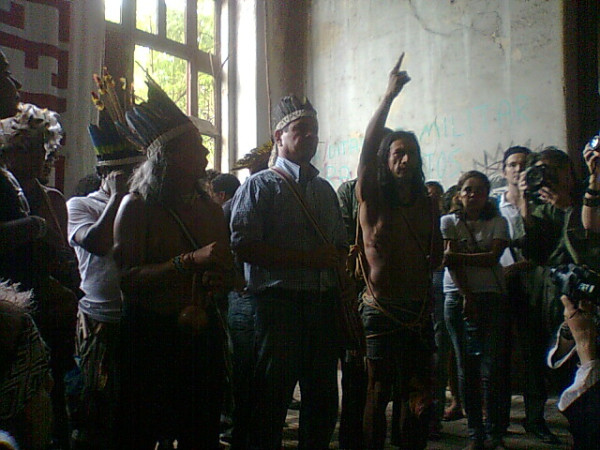About six years ago, the abandoned building of the First Museum of the Indian, in Rio de Janeiro, Brazil turned into a “living museum” and became home to several different indigenous communities.
This new settlement was close to the city's famous Maracanã stadium, and soon became known as Aldeia Maracanã or Maracanã Village.
On the morning of January 12, 2013, Maracanã Village woke up surrounded by military policy in riot gear. Without warning and without a warrant [pt], the military police arrived ready to evict the community. The area around Maracanã stadium is undergoing major reconstruction in preparation of the 2014 World Cup and the 2016 Olympics.
The official page of Maracanã Village on Facebook, created a few months earlier on November 2012, made a call for support. Soon dozens of human rights activists arrived at the scene.
In a video report [pt] by the collective TVMemóriaLatina [pt] members of the community stated that they would resist peacefully.
During the day, about 200 activists gathered to protect the village. The Federal Deputy Marcelo Freixo of the Party for Socialism and Liberty (PSOL/RJ), and President of the Commission for the Defence of Human Rights and Citizenship also showed up and had to climb the wall of the village in order to talk to the indigenous leaders entrenched inside.
“People who want to support the struggle keep pouring in by the side wall”, Combate Racismo Ambiental reported. A worker from the Maracanã’s construction site was fired after joining the sit-in. Conexão Jornalismo reports [pt] and adds:
A reação dos índios, a participação popular e de lideranças políticas, além do papel exercido pelas mídias alternativas – independentes de compromisso com as decisões do governador e prefeito – surpreenderam o governo Estadual.
The reaction of the indigenous, and the participation of the people and political leaders, besides the role played by alternative media – independent of compromises with the decision of the governor and mayor – surprised the State government.
After hours of tense negotiation between the police, activists, politicians and representatives of the Public Ministry, the police decided to leave the scene [pt].

Photo by Carlos Latuff (@CarlosLatuff) “Indigenous leaders speak to those present at the Maracana Village” http://twitpic.com/bumy2p
The moment the gates reopened was recorded on video, together with the reaction of the musician Yuka. Rapper and soul artist from São Paulo, Criolo, was also in Rio for a show that day and encouraged his massive audience to make a lot of noise in support of the Maracanã Village. “How the hell can [he] overthrow me or think of overthrowing the museum of the Indian to make a parking lot?”:
Collective Geração Invencivel, who covered the day of tension on their Facebook page, created an event for a protest taking place on January 15, called by the Students Popular Revolutionary Movement (MEPR, Movimento Estudantil Popular Revolucionário).
An article published on the Washington Post with the headline “Indigenous squatters living by Rio’s Maracana stadium” triggered some outrage, such as Angela Toledo’s recalling the Canadian #IdleNoMore movement:
It’ has come to this, Indigenous people being called “squaters” what next? The games should be in prol of people not against them! Boycott #WorldCup if fairness and due process not followed. #idlenomore!
And Andrea Neves, who lives in Maracanã, said:
It´s a bad thing that the govermmant whants [sic] to do with us: Tear a Museun and a Shchool [sic] down for the 2014 World Cup. We need help from the international press, because the majority of people doesn´t know what is happening, specially the politicians trying to unthercover. [sic]
“We want to be a Living Museum”
The historical and cultural heritage of the 147 year-old building is unquestionable. It was the first Museu do Índio (The Museum of the Indian), created by Darcy Ribeiro in 1953, and in 1977 it was moved to the Botafogo district, where it has been fully functional until now.
Agência Olhares has created a documentary about the struggle and hopes of the dwellers:
A group of Brazilian indians, belonging to different ethnic groups from all over the country, has occupied, since October 2006, an old colonial building abandoned.
This building had previously hosted the ancient Indian Museum, until 1977, when the Museum was moved to its present location, in the district of Botafogo. In the coming month, the indians’ struggle to defend this space that it is theirs by right, will be very tough. With the renovation of the nearby stadium Maracana, Rio Prefecture may decide to demolish the building, to make there a parking lot or a shopping center.
The Indians want to create the first indigenous university in Brazil
A campaign has been launched on the Pressure Cooker [pt] platform of the non-profit organization for civic participation, Meu Rio. The petition [pt] is addressed to the Governor of the State of Rio de Janeiro, Sérgio Cabral, and has already received 1,614 direct messages from supporters of the village. It demands “that the Governor undertakes not to bring down the building of the former museum of Indian and ensures the permanence of the people in the current Maracanã Village.” The Public Prossecutor André Ordacgy is quoted saying [pt]:
Todos os órgãos, com exceção do governo do estado, são contrários à demolição. Temos um parecer do Conselho Regional de Engenharia e Agronomia (Crea) contrário à demolição. Também o Instituto do Patrimônio Histórico e Artístico Nacional (Iphann) está contra.
All organs, except for the state government, oppose to the demolition. We have the opinion from the Regional Council of Engineering and Agronomy (CREA), contrary to demolition. Also the Institute of National Historical and Artistic Heritage (Iphann) is against it.








9 comments